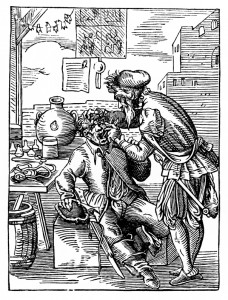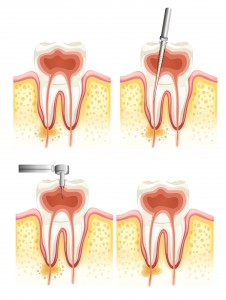 In ancient civilizations, people believed that root canal infections were caused by a worm that lived within a tooth, and that killing the worm healed the tooth. When this belief was debunked, historical documents indicate people believed these infections were caused by poorly aligned humors (blood, phlegm, black and yellow bile), and the method for curing root canal infection was extraction and bloodletting. Ironically, both infection removal and tooth extraction are still used to treat root canal infections today. The difference is that modern dental practitioners understand the cause of root canal infection, and can better treat the problem and remove the associated discomfort. At Westside Dental Associates, Dr. Les Latner and his skilled dentistry team help patients relieve the pain of root canal infection, and keep their smiles happy and healthy.
In ancient civilizations, people believed that root canal infections were caused by a worm that lived within a tooth, and that killing the worm healed the tooth. When this belief was debunked, historical documents indicate people believed these infections were caused by poorly aligned humors (blood, phlegm, black and yellow bile), and the method for curing root canal infection was extraction and bloodletting. Ironically, both infection removal and tooth extraction are still used to treat root canal infections today. The difference is that modern dental practitioners understand the cause of root canal infection, and can better treat the problem and remove the associated discomfort. At Westside Dental Associates, Dr. Les Latner and his skilled dentistry team help patients relieve the pain of root canal infection, and keep their smiles happy and healthy.
Root Canal Infection Facts from Your Los Angeles Dentist
- Root canal infection occurs when, due to trauma or advanced decay, a tooth’s interior pulp layer is infected. The pulp contains the tooth’s nerves and blood vessels that connect with the body through canals in the root of the tooth. The tooth’s outer enamel and dentin layers are thinnest in the root, and most pulp infections are caused by bacterial buildup and decay beginning in the root. Thus, the infection and treatment are commonly referred to as root canals.
- Root canal infection and any other dental concern that involves the interior of the tooth falls under the dental specialty of endodontics (endo – inside, odont – tooth).
- While some patients still require extraction to treat root canal infection, most dentists will preserve natural dentition with root canal therapy.
- Many patients have learned that a root canal “kills” the tooth, but this is not the case. The pulp and any infection inside the tooth are removed. This includes the nerves and blood vessels inside which were believed to be the “life” of the tooth, but after development, the tooth’s blood vessels serve no function and the nerves are pain receptors. The tooth’s enamel absorbs nutrients (fluoride and phosphates) that strengthen it from the outside.
The Root Canal Therapy Los Angeles Relies On
A recent study by the American Association of Endodontists revealed that there are roughly 40 million root canal procedures performed in the US annually, and that 85% of patients who receive root canal therapy return to the dentist who performed their procedure for future dental care. With a 95% success rate, root canal therapy retains natural dental structure, relieves pain, and puts a beautiful smile back on patients’ faces. Here’s how root canal therapy at Westside Dental Associates works:
- The first step in the root canal process is removing the infected tissue within the tooth. This is done using increasingly larger files. These files look like tiny swords, and have serrated edges that pull infected tissue out of the tooth.
- Once the infection is removed, patients may need to undergo a round of antibiotic treatment (topical or oral) to ensure the procedure’s success. This is more likely for severe infections that have spread to the gums or surrounding teeth.
- For most patients, directly following the removal of infection, the tooth is filled with gutta percha, a biocompatible material that mimics the pulp supporting the dental structure.
- Finally, the visible portion of the tooth is restored with a dental crown.
Call the Dentist 90064 Residents Trust for Pain Relieving Root Canal Therapy
If you’re experiencing extreme pain, sensitivity to heat or cold, or notice one tooth that is discolored, you may have a root canal infection. Call Dr. Latner and his dental team for pain relieving root canal therapy Los Angeles residents rely on. At Westside Dental Associates, we help patients relieve the pain of root canal infection leaving them with a smile they’re proud to share.

